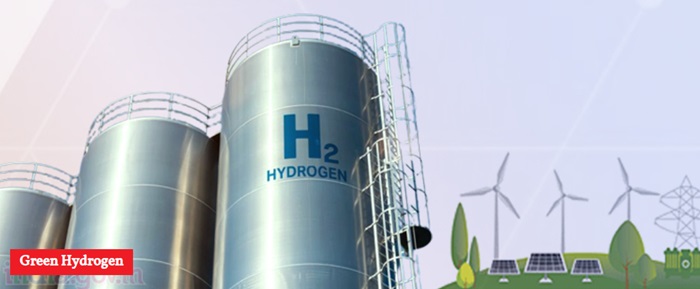
The Ministry of New and Renewable Energy (MNRE) has taken a significant step towards decarbonizing the transport sector with the release of guidelines for pilot projects under the National Green Hydrogen Mission.
The National Green Hydrogen Mission seeks to foster innovation and widespread adoption of green hydrogen technologies within the transportation industry.
Its primary objective is to integrate green hydrogen as a fuel source for various vehicles, including four-wheelers, buses, and trucks.
The initiative underscores the government’s commitment to promoting clean energy solutions and tackling climate change through advancements in the transportation sector.
Carried out in partnership with the Ministry of Road Transport and Highways and other agencies, these programmes place also emphasize infrastructure development, such as building hydrogen refuelling stations and exploring innovative applications of hydrogen.
This includes researching the feasibility of using green hydrogen-derived methanol/ethanol and other synthetic fuels in vehicles.
She announced a significant 102% increase in funding for the National Green Hydrogen Mission which translates to an allocation of ₹600 crore for 2024-25, compared to ₹297 crore in the previous year.
The release of the guidelines for pilot projects under then National Green Hydrogen Mission came in the wake of this allocation.
The Indian government launched the National Green Hydrogen Mission on August 15, 2021.
During his address to the nation on India’s 75th Independence Day, Prime Minister Narendra Modi reiterated the government’s commitment to combating climate change through the introduction of the National Hydrogen Mission.
He emphasized the goal of surpassing the targeted 100 GW renewable energy achievement by 2030 and highlighted the crucial role of green hydrogen in meeting India’s climate objectives.
Hydrogen’s potential as a clean fuel dates back centuries, from Jules Verne’s dreams to powering Apollo missions.
Despite advancements by companies like Honda and Toyota, challenges persist.
Green hydrogen, derived from renewables, is the cleanest but needs scaled-up production.
In India, with a coal-centric grid limiting electric vehicles, hydrogen emerges for long-haul transport.
Slow adoption is due to a lack of hydrogen fuelling stations, safety concerns, and the pivotal challenge of scaling up technology.
India’s Hydrogen Energy Mission strives to overcome these hurdles for a cleaner hydrogen-powered future.
In September 2022, top officials from the EU and India launched a forum to accelerate cooperation on green Hydrogen.
Both parties envisaged green hydrogen as key to energy security, supply chain development, and sustainable development.
The EU was particularly motivated by the recent Ukraine crisis, which ignited their desire for energy independence.
The National Green Hydrogen Mission received an initial investment of Rs 19,744 crore, which was distributed across four key areas. Rs 17,490 crore is allocated for the Strategic Interventions for Green Hydrogen Transition (SIGHT) program, which aims to boost infrastructure and production capacity.
Rs 1,466 crore were set aside for pilot projects to test the feasibility and effectiveness of using green hydrogen in various sectors like transportation and industry.
Rs 400 crore were allocated for research and development to advance green hydrogen technologies and make them more affordable. Rs 388 crore is reserved for other essential aspects of the mission, such as capacity building and awareness campaigns.
Additionally, a substantial sum was dedicated to research and development, aiming to position us as global leaders in this field. Missing out on this opportunity again wasn’t an option, and this initiative appeared to be steering the country in the right direction.
Maharashtra became the first state of the country to introduce a green hydrogen policy.
The policy aims to produce five million tonnes of green hydrogen annually in the country by 2023.
It will provide incentives to projects that procure renewable energy through open access, from in-state or out-of-state power distribution companies, power exchanges, for self-consumption.
Standalone and hybrid power plants will be given 100 per cent concession in power tariff for the next 10 years and 15 years respectively and will also be exempted from cross subsidy and surcharge.
Around the same time, The World Bank announced the investment of $1.5 billion to help India develop low-carbon energy.
This included expanding renewable energy, developing green hydrogen (fuel created from water using renewable electricity), and attracting private investment. Green hydrogen is crucial for decarbonizing hard-to-abate industries like steel and fertilizer.
India’s biggest fuel company, Indian Oil Corporation (IOC), began testing green hydrogen-powered buses in Delhi and surrounding areas in September 2023.
Petroleum Minister Hardeep Singh Puri launched the trial with two Tata Motors-built hydrogen fuel cell buses, aiming to expand to 15 buses by year-end.
These buses offered an attractive alternative to traditional fuels, boasting near-zero emissions and greater efficiency than internal combustion engines.
By leveraging the expertise of Indian Oil Corporation for this initial project, the government made a wise decision.
However, expanding access to green hydrogen will require further expertise development and international partnerships.
These pilot projects are envisioned to nurture a green hydrogen ecosystem within the transportation industry.
The government actively supports this objective by promoting infrastructure development, including refuelling stations and distribution networks, to facilitate the broader adoption of green hydrogen.
Notably, with the anticipated decrease in green hydrogen production costs, green hydrogen-based vehicles are expected to become more practical and widely adopted in the coming years, ultimately advancing environmentally responsible and sustainable practices in transportation.
Adoption of Green Hydrogen also presents an opportunity for energy independence, potentially replacing, or at least reducing, fossil fuel imports worth Rs 1 lakh crore by 2030.
Recognizing this potential, significant investments have been made to bolster renewable energy capacity and create an incentivized ecosystem conducive to Green Hydrogen development.
These combined efforts pave the way for a greener future powered by sustainable and self-sufficient energy sources. (India Blooms)